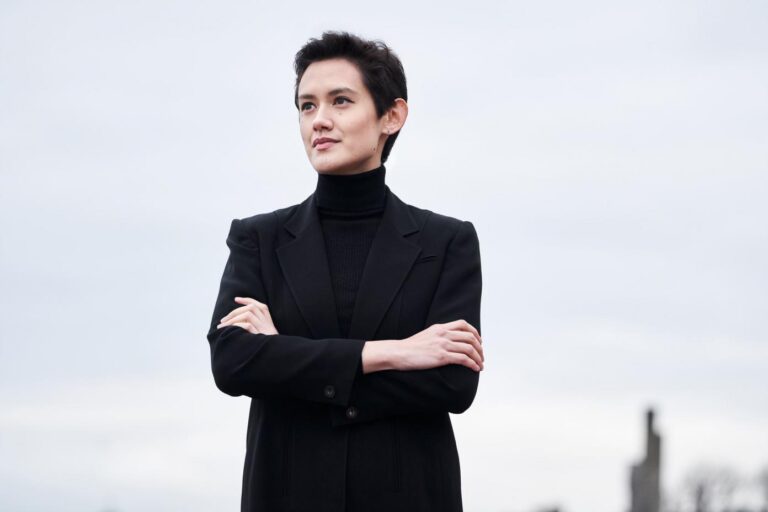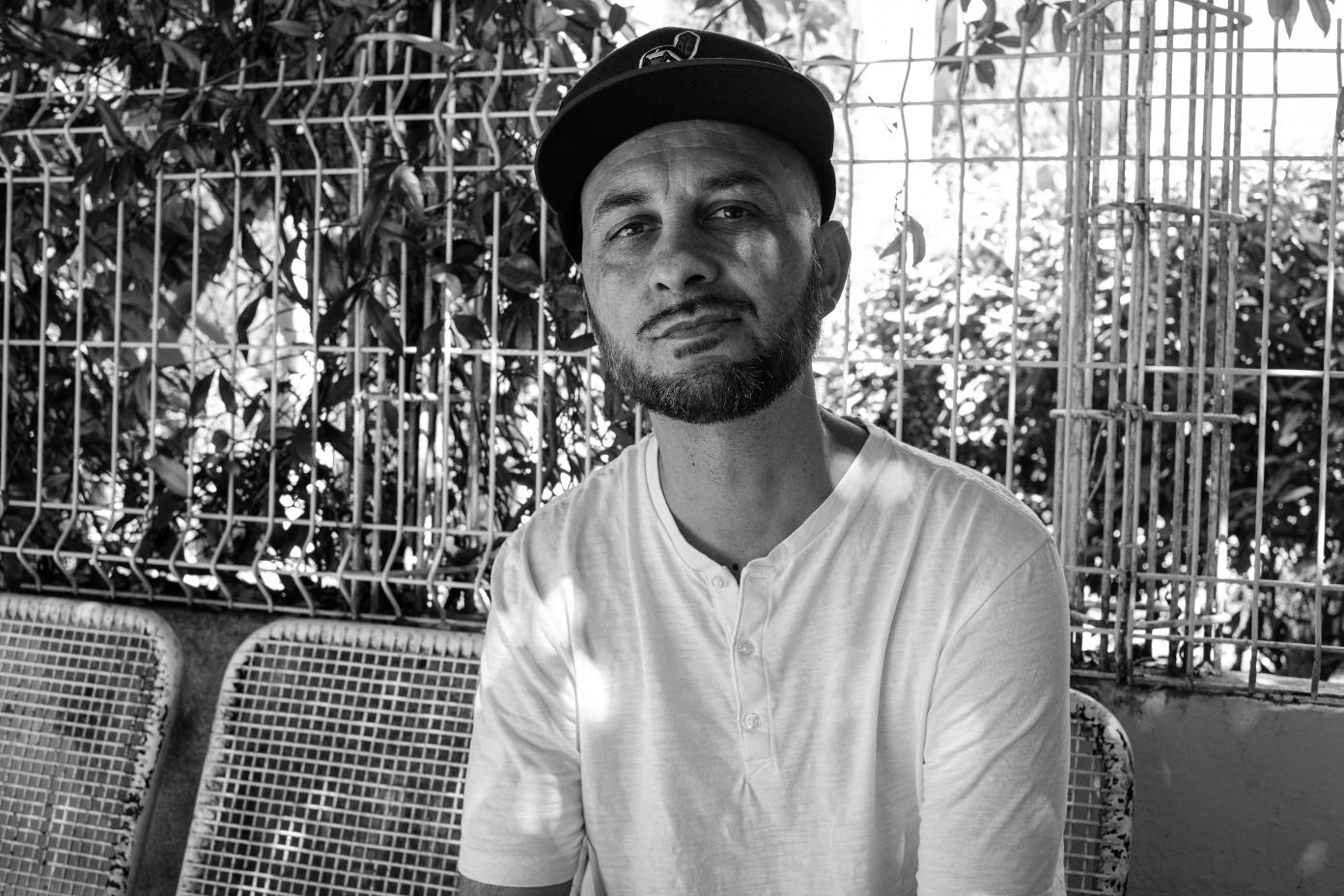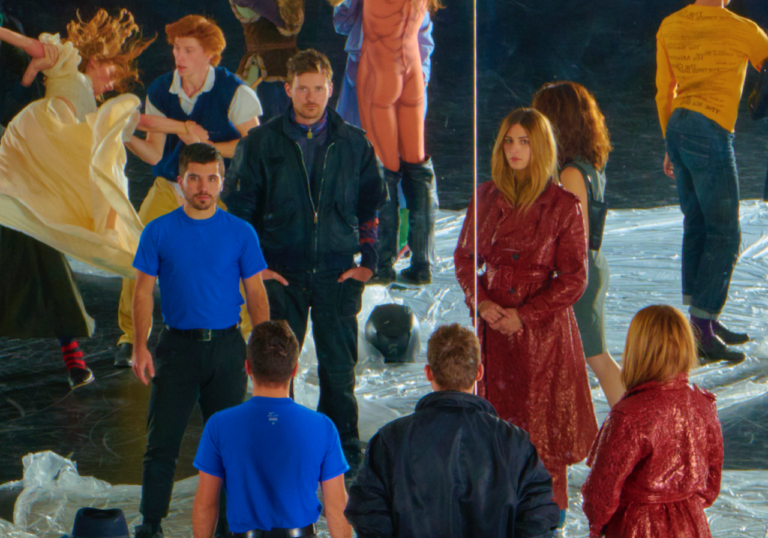
Sameer Ahmad: “The America I shaped my personality around was a complete fantasy”

By Anthoni Dominguez
What brings together Bruce Lee, skateboarding, Clint Eastwood, rap… and the small Norman town of Flers? When he was a young Iraqi refugee, Sameer Ahmad built up a very personal culture – the product, as he says today, of a fantasized vision of America. Having become one of the most interesting French Hip Hop musicians of his generation, he deconstructs this mythical vision in his texts.
You fled Iraq with your father, heading first for Algeria, then for France. What are your memories of arriving in France and learning French, which has become your language of artistic expression?
My first memory of arriving in France is the film The Mad Adventures of Rabbi Jacob, starring Louis de Funès. We didn’t really understand it, even though I’d started learning some French in Algeria, which was still partly French-speaking because of its colonial past. To me, de Funès was the embodiment of all things French. So our first contact was essentially through the funny faces he pulled, which had us thinking that the whole country was inhabited by crazy people who didn’t take themselves seriously. Another character in the film, Slimane, spoke a fake Arabic, which really made us laugh. So I don’t have the harsh kind of memories a lot of other immigrants have, whose first impressions of France involve the cold, the snow, suspicious glances… Not at all! I found it funny, welcoming, and even cool! Far more, in any case, than anything I’d experienced before.
As for learning French – my mother spoke it fluently, but we only started it using in our daily lives when we settled in France. My father picked it up very quickly – in fact, my brother and I recently found an old 90-minute tape, recorded when I must have been about seven or eight, on which he tells us, in French, about his life. I remember him doing that in the evenings, instead of reading us a bedtime story: he told us about his life, in French. After only a few years in France, it became our official family language.
You essentially define your rap as a relationship to the spoken word, hardly at all as a form of writing. Is it a way for you to react to a sort of complex that French rap still has today, in that it feels it has to define itself in relation to poetry or protest songs, as if it couldn’t be a genre in its own right?
Well, yes, there is a difference between my way of doing rap and that of Sako, from the band Chiens de Paille, for example, a musician I really admire and have worked with. He writes before he raps, whereas I start by listening to the music, then I rap, and then sometimes I write so I don’t forget. But I don’t systematically write. It’s always the same process: I play the backing track, I find sentences, I play around with the sounds a lot rather than just focusing on the rhymes, and then maybe I write. But it’s tricky, because sometimes, when I write it down, I lose what I have just rapped, which is connected to pure sound. When I’m making music, I want non-French speaking listeners to be able to appreciate it, even if they don’t understand the text. If there’s substance that’s a plus, of course, but it isn’t the most important thing. I really want to work on developing intricate rhymes, unexpected twists, breaking the flow with a certain nonchalance… a kind of swing! It’s not just about rapping; I must find my voice. Anyone can rap; it’s like blowing in a trumpet, playing the piano, or guitar. Anyone can learn two or three chords. It’s not what you say that’s important, but the way you say it.
Do you have a fixed creative process? How did you make an album like “Effendi,” for example?
Every day, no matter what, I force myself to write between four and eight bars, sometimes as many as twelve – bars that I may or may not use. I have thousands of notes, arrangements of ideas, rhymes, words, etc. When I start the creative process with my collaborators, we find a color, an atmosphere, a guideline in terms of the vocabulary and the grain of the music. That’s the longest and hardest part: choosing a sound, suggesting an idea, adopting a lexical field, defining the rhythm and the BPM (tempo). That’s when I get my notes out, and pick and choose from them. Once we have gotten all that material together, we work on the music and the lyrics at the same time.
Does that mean you already have an idea of the tempo before you have the melody?
Yes, sometimes I have an idea, or the beat takes over. On Pazuzu, for example, we opted for a very slow BPM that led me to a specific type of creation. To begin with, I just had that word, “Pazuzu,” and a couple of rhymes as starting points for the creative process. Once I’ve settled on the tempo, I start writing, and things can move ahead pretty quickly. I can actually make a new piece every day, but the hardest thing is finding something original. Of course, some pieces, such as Nora Miao, are quick, and I’d even say easy to write, while others, such as Vera Cruz or Pazuzu, have specific rhythms and swings that take more work. Everything has a really precise tempo, so I will add or remove a syllable here and there. In fact, it becomes fun when there are a lot of constraints. I can no longer churn out pieces, like Mon polo, the way I used to. I like 50 BPM pieces, for example, because you can create a different flow and, above all, tell stories that are completely different. A phrase can go completely unnoticed at a certain tempo and become grandiose at another. That’s why I often reuse and recalibrate whole phrases in my pieces. “Mon âge tendre s’est fait rouer de coups de vieux” went unnoticed on my album Un amour suprême, but when I used it again on Apache, people took it up straight away because it was at the right BPM and had the right wordplay.
That’s an interesting example, because you reuse a lot of phrases from past projects in new ones, sometimes altering them. Where does that habit come from?
It’s a way of showing that, basically, I’ve been working on the same project since I started. It’s always me, doing the same thing, making the same record. It’s only the form and packaging that change. I don’t make new albums; it’s been the same one all along.
So your culture is a combination of the legacy of your Iraqi origins, your arrival in France, and your later passion for skateboarding and jazz. What’s the connection between those disciplines?
When I was about 13, I discovered skateboarding through videos from the U.S., and it was a mind-blowing experience. It changed everything. I found the whole thing fascinating: the style, the atmosphere… In a sense, I was already making figures. It was a lifestyle that introduced me to musical styles, groups like Primus, NOFX, Pennywise, and the whole California scene. It really knocked us out! I was living in Flers, a little town in Normandy, and the skate culture really allowed me to be myself, even though we were nerds. Funnily enough, it was also my passion for skateboarding that introduced me to jazz, through the musicians often featured in the videos, like Yusef Lateef. I remember a piece by Miles Davis, Lonely Fire, that Mobb Deep had sampled on The Infamous, which suddenly made me aware of all the connections between those musical genres. And at that time in my life, there was also the joy of discovering and tracing the links between different cultures. After we’d watched the videos, we’d go to the media library to look for the things we’d heard – Curtis Mayfield, De La Soul, Tribe Called Quest, Souls of Mischief, Smif-n-Wessun, and so on – and because we could order stuff, about fifteen of us skaters ordered records that arrived the following month. It was a fabulous time, the best years of my life! And just as Sergio Leone created his own America in Almeria, we created our own Far West in Flers. There was a little spot we called San José, another we called Venice, there was the Justin Herman Plaza, I went by the name Sam… We were totally matrixed!
There are a lot of references to American culture – whether it’s jazz, cinema, basketball, baseball, or hip-hop – in your songs… What did the United States represent in your self-construction as an individual, and how did your family react?
The America I shaped my personality around was obviously a complete fantasy. When I was young, the United States wasn’t New York; it was California, San Francisco and, to a lesser extent, Los Angeles. That was my dream when I was 13, I’d have given anything to visit San Francisco. It was the city of skateboarding, the capital of cool, the laid-back lifestyle, the hippie history, tolerance – a city where you could be whoever you wanted, without judgment…
My father just didn’t get it. Before all that, I’d been fascinated by Bruce Lee and I did karate. My father was really pleased because karate is an upstanding, disciplined sport, with a sensei, a timetable… it was almost soviet-like! He loved the respectful, hardworking aspect, which matched his other obsession: “School, school, school. Learning French, Learning French, Learning French… When your name is Samir, you have to be top of your class, because if you’re joint first with Frédéric, they’ll always go for Frédéric.” So when I discovered skateboarding and gave up all the rest, he didn’t understand. There was no teacher, no timetable, I was always taking tumbles, the clothes, the music – for him, it was absolutely ridiculous. But I was doing okay at school and I made a lot of progress skateboarding, so he gradually accepted it.
What I liked about the States was the entertainment side of it; I wasn’t interested in what was happening in terms of politics, I had no particular political demands. In any case, to my mind, we were French, we were no longer Iraqi. I saw myself as a French fan of San Francisco, a fan of rap, jazz and Hollywood blockbusters. It was the 1990s, we hadn’t yet experienced the coming wave of Asian movies or the international rap that would submerge all the rest. We used to buy Dakatine, a sort of sweet peanut spread, because there wasn’t any peanut butter in France. We would watch Zack Morris skateboarding to school in Saved by the Bell, while we were in our gray apartment blocks in the cold. So we would try to do all that in our little industrial town. It cheered us up, and it kept us safe from drinking and smoking weed to get high, like other 15 year-olds.
In “Sitting Bull,” you contrast the Sioux chief with Clint Eastwood. Isn’t there something ambivalent about your relationship to American culture?
That piece doesn’t directly reference the United States. It’s a metaphor for the underdog who beats the oppressor. When I was a child, like everyone else I was on the cowboys’ side because I didn’t know any better; I’d always been told that the Indians were the bad guys. Now, on that subject and many others, I’ve realized that history is written by the winners. But “Clic-clic-boom-Clint-East-Wood-Sitting-Bull” is pure sound, first and foremost – which is the essence of spoken word. If I say, “I think a paradigm shift is in order where values are concerned, and the winner isn’t always right,” it has no style. But if I say, “Clic-clic-boom, que Sitting Bull nous goume Clint Eastwood,” it means exactly the same thing, but it doesn’t sound as dopey. In fact, it’s much more stylish.
When I talk about Bruce Lee in Fist of Fury, I talk about the Japanese occupation of China, so once again it’s about the violence of the oppressed. I love that movie, about a guy who decides to avenge his master’s death. He’s actually a damaged individual who uses that loss to justify his psychopathic impulses and kill as many Japanese as he can. It’s how he legitimizes his ultra-violence; above all, he wants to prove that he’s the strongest, and maybe even have some fun. He knows perfectly well that no matter how many adversaries he beats up and people he kills, and no matter how much he enjoys it, it’s essentially useless. His friends get offed one by one, but he keeps on, to the bitter end! It’s completely nihilistic – and, consequently, very romantic, in a way. The Afro-descendant communities in the Arab and African countries and in the States loved that movie because it was the story of an underdog who rises up against his oppressors – but above all because it had a non-white, third-world hero. It was the first time those people felt represented on a worldwide scale.
After the United States, France is now the second largest market for rap in the world, in terms of sales, audience, and creativity. In fact, the period since 2015 has been described as the “second golden age of French rap.” Does that expression make you feel you’re part of a certain generation, that you encouraged the emergence of a new scene?
No, not really. If you had asked me that very same question between 2010 and 2015, I would probably have replied in the affirmative, because I had a sense of being part of something new, alongside artists such as Nemir, Taïpan, and L’Entourage. We turned up with original ideas and more sophisticated sounds, inspired by rappers like Curren$y. They were singular artistic proposals that found a certain audience. What people started calling the “new golden age” after 2015 was actually more of a marketing gimmick than any real artistic phenomenon. The expression encompassed all sorts of things. You must remember that, in France, “la variété” (commercial music) always wins out. People say rap is everywhere today, but it’s been infiltrated. It’s like when they used to say that rock was everywhere – but who was the face of French rock? Alain Souchon? Please. Souchon’s fine, but his music wasn’t rock, it was French commercial music, like Patricia Kaas, who supposedly “sang the blues.” Even Johnny Hallyday ended up making commercial music. There isn’t a pop culture in France the way there is in the US or the UK. Today, it’s become clear that commercial music has won out again; it’s just sprinkled with rap. It has won out, but doesn’t say so, and when it has killed rap, it will go on to infiltrate another movement. They say there’s a niche rap, but rap is a niche in itself in France. I turned to rap because I hated French commercial music and pop rock; I hated all that, though I like British 1970s pop rock. I liked French rap because it wasn’t commercial. So I’m not going to start listening to it today on the pretext that there’s a hint of rap in it. French commercial music can take whatever form it likes, I will always hate it. It has even attacked classical music, with people like André Rieux who “popularized” it, or rock, with Dick Rivers, who sells more records than Chuck Berry ever did in France. Let’s not forget that rap gained acceptance in France through the pop duo Chagrin d’Amour and through MC Solaar.
Your intention in Miami is to make a portrait of a certain American (or even “Miamian”) dream and its limits, in collaboration with the diaspora communities that fled the authoritarian regimes of the Caribbean and Latin America. What are you hoping to find through contact with those communities?
When I approach a subject, it’s always through something tangible. If I want to talk about my first loves, those that helped me escape the everyday, I’ll talk about the actress Nora Miao. In Miami, I’m following in the tracks of baseball player José Fernandez who, in my view, epitomizes the whole history of the Cuban diaspora, and of diaspora communities in general. He is a symbol of the American dream and the fall that Miami will inevitably experience before the end of the century due to climate disruption. I want to work around him – not the character as such, but what he represents – in order to recount a story. His life is a mirror that will help me tackle the departure from Cuba, his arrival in Miami, his discovery of baseball, his outsized influence on that world, the mental challenges he faced, how he’s perceived by the Latino community… Musically, visually, on the literary level, he’s an incredible figure. I want to understand his story and cover it from every angle.
Based in Montpellier, rap artist Sameer Ahmad has written five albums: “Justin Herman Plaza,” “Perdants Magnifiques,” “Apaches,” the diptych “Un Amour Suprême : Jovontae & Ezekiel” and “Effendi.” As a child, he emigrated from France to Iraq then to Algeria, along with his father, a political refugee, and moved to France in 1985. He first got into rap after discovering the world of skateboarding in the city of Flers, in the Orne department (northwestern France).


